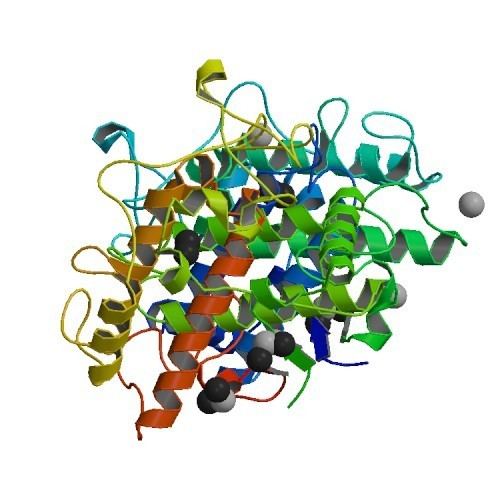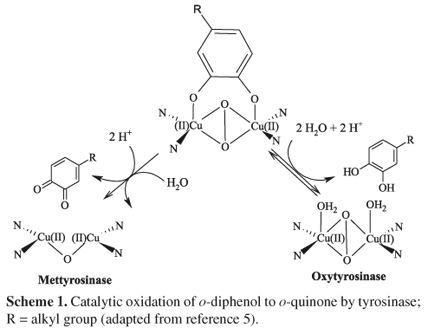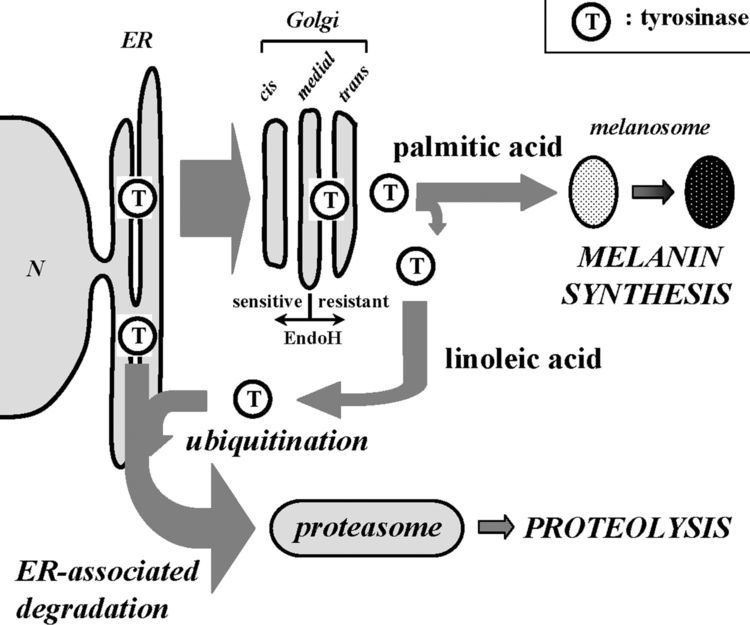Entrez 7299 | Ensembl ENSG00000077498 | |
 | ||
Aliases TYR, ATN, CMM8, OCA1, OCA1A, OCAIA, SHEP3, tyrosinase, Tyrosinase External IDs | ||
Tyrosinase
Tyrosinase is an oxidase that is the rate-limiting enzyme for controlling the production of melanin. The enzyme is mainly involved in two distinct reactions of melanin synthesis; firstly, the hydroxylation of a monophenol and secondly, the conversion of an o-diphenol to the corresponding o-quinone. o-Quinone undergoes several reactions to eventually form melanin. Tyrosinase is a copper-containing enzyme present in plant and animal tissues that catalyzes the production of melanin and other pigments from tyrosine by oxidation, as in the blackening of a peeled or sliced potato exposed to air. It is found inside melanosomes which are synthesised in the skin melanocytes. In humans, the tyrosinase enzyme is encoded by the TYR gene.
Contents
- Tyrosinase
- Tyrosinase enzyme video
- Clinical significance
- Significance in food industry
- Significance in insects
- Catalyzed reaction
- Structure
- Human tyrosinase
- Active site
- Gene regulation
- References

Tyrosinase enzyme video
Clinical significance

A mutation in the tyrosinase gene resulting in impaired tyrosinase production leads to type I oculocutaneous albinism, a hereditary disorder that affects one in every 20,000 people.

Tyrosinase activity is very important. If uncontrolled during melanoma, it results in increased melanin synthesis. Decreasing tyrosinase activity has been targeted for the betterment or prevention of conditions related to the hyperpigmentation of the skin, such as melasma and age spots.
Several polyphenols, including flavonoids or stilbenoid, substrate analogues, free radical scavengers, and copper chelators, have been known to inhibit tyrosinase. Henceforth, the medical and cosmetic industries are focusing research on tyrosinase inhibitors to treat skin disorders.
Significance in food industry

In food industry, tyrosinase inhibition is desired as tyrosinase catalyzes the oxidation of phenolic compounds found in fruits and vegetables into quinones, which gives an undesirable taste and color and also decreases the availability of certain essential amino acids as well as the digestibility of the products. As such, highly effective tyrosinase inhibitors are also needed in agriculture and the food industry. Well known tyrosinase inhibitors include kojic acid, tropolone, coumarins, vanillic acid, vanillin, and vanillic alcohol.
Significance in insects

Tyrosinase has a wide range of functions in insects, including wound healing, sclerotization, melanin synthesis and parasite encapsulation. As a result, it is an important enzyme as it is the defensive mechanism of insects. Some insecticides are aimed to inhibit tyrosinase.
Catalyzed reaction
Tyrosinase carries out the oxidation of phenols such as tyrosine and dopamine using dioxygen (O2). In the presence of catechol, benzoquinone is formed (see reaction below). Hydrogens removed from catechol combine with oxygen to form water.
The substrate specificity becomes dramatically restricted in mammalian tyrosinase which uses only L-form of tyrosine or DOPA as substrates, and has restricted requirement for L-DOPA as cofactor.
Structure
Tyrosinases have been isolated and studied from a wide variety of plant, animal, and fungal species. Tyrosinases from different species are diverse in terms of their structural properties, tissue distribution, and cellular location. No common tyrosinase protein structure occurring across all species has been found. The enzymes found in plant, animal, and fungal tissue frequently differ with respect to their primary structure, size, glycosylation pattern, and activation characteristics. However, all tyrosinases have in common a binuclear, type 3 copper centre within their active sites. Here, two copper atoms are each coordinated with three histidine residues.
Human tyrosinase
Human tyrosinase is a single membrane-spanning transmembrane protein. In humans, tyrosinase is sorted into melanosomes and the catalytically active domain of the protein resides within melanosomes. Only a small, enzymatically inessential part of the protein extends into the cytoplasm of the melanocyte.
As opposed to fungal tyrosinase, human tyrosinase is a membrane-bound glycoprotein and has 13% carbohydrate content.
The derived TYR allele (rs2733832) is associated with lighter skin pigmentation in human populations. It is most common in Europe, but is also found at lower, moderate frequencies in Central Asia, the Middle East, North Africa, and among the San and Mbuti Pygmies.
Active site
The two copper atoms within the active site of tyrosinase enzymes interact with dioxygen to form a highly reactive chemical intermediate that then oxidizes the substrate. The activity of tyrosinase is similar to catechol oxidase, a related class of copper oxidase. Tyrosinases and catechol oxidases are collectively termed polyphenol oxidases.
Gene regulation
The gene for tyrosinase is regulated by the microphthalmia-associated transcription factor (MITF).
